A Reliable Treatment of Homotopy Perturbation Method for Solving the Nonlinear Klein-Gordon Equation of Arbitrary (Fractional) Orders
Abstract
The reliable treatment of homotopy perturbation method (HPM) is applied to solve the Klein-Gordon partial differential equation of arbitrary (fractional) orders. This algorithm overcomes the difficulty that arises in calculating complicated integrals when solving nonlinear equations. Some numerical examples are presented to illustrate the efficiency of this technique.
1. Introduction
The Klein-Gordon equation plays a significant role in mathematical physics and many scientific applications such as solid-state physics, nonlinear optics, and quantum field theory [1, 2]. The equation has attracted much attention in studying solitons [3–6] and condensed matter physics, in investigating the interaction of solitons in a collisionless plasma, the recurrence of initial states, and in examining the nonlinear wave equations [7].
The HPM, proposed by He in 1998, has been the subject of extensive studies and was applied to different linear and nonlinear problems [8–13]. This method has the advantage of dealing directly with the problem without transformations, linearization, discretization, or any unrealistic assumption, and usually a few iterations lead to an accurate approximation of the exact solution [13]. The HPM has been used to solve nonlinear partial differential equations of fractional order (see, e.g., [14–16]). Some other methods for series solution that are used to solve nonlinear partial differential equations of fractional order include the Adomian decomposition method [17–19], the variational iteration method [20–22], and the homotopy analysis method [23–25].
2. Basic Definitions
Definition 2.1. A real function f(t), t > 0, is said to be in the space Cμ, μ ∈ ℝ, if there exists a real number p > μ, such that f(t) = tpf1(t), where f1(t)∈C(0, ∞), and it is said to be in the space if f(m) ∈ Cμ, m ∈ ℕ.
Definition 2.2. The Riemann-Liouville fractional integral operator of order α ≥ 0 of a function f(t) ∈ Cμ, μ ≥ −1 is defined as [28]
- (1)
JαJβf(t) = Jα+βf(t),
- (2)
JαJβf(t) = JβJαf(t),
- (3)
Jαtγ = (Γ(γ + 1)/Γ(γ + α + 1))tα+γ.
Definition 2.3. The fractional derivative in Caputo sense of , m ∈ N, t > 0 is defined as
- (1)
,
- (2)
,
- (3)
.
3. The Homotopy Perturbation Method (HPM)
4. Numerical Implementation
In this section, some numerical examples are presented to validate the solution scheme. Symbolic computations are carried out using Mathematica.
Example 4.1. Consider the fractional-order cubically nonlinear Klein-Gordon problem
Case 1 (α ∈ (1,2] and β = 2). Solving (4.2), we obtain
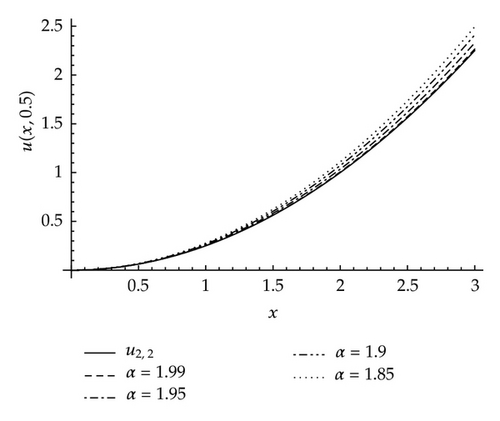
Case 2 (α = 2 and β ∈ (1,2]). Solving (4.2), we have

Case 3 (both α and β ∈ (1,2]). Solving (4.2), we have
Figure 3 gives the comparison between the HPM 6th-order approximate solution of problem (4.1) in Case 3 with α and β taking the values 1.99,1.95,1.90, and 1.85 and the solution of corresponding problem of integer order denoted by u2,2 at t = 0.5.
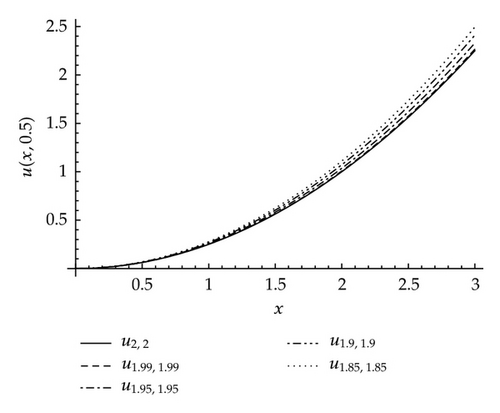
Example 4.2. Consider the fractional-order cubically nonlinear Klein-Gordon problem
Case 1 (α ∈ (1,2] and β = 2). Solving (4.7), we have
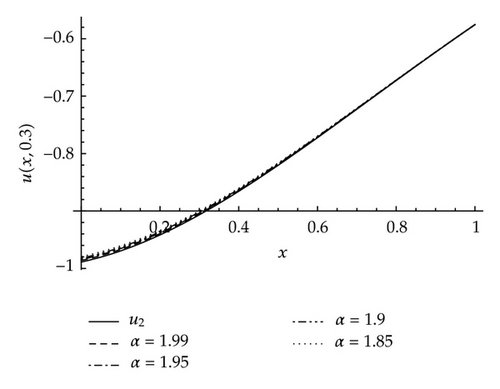
Case 2 (α = 2 and β ∈ (1,2]). As the attempt to evaluate Caputo fractional derivative of the functions sech(x) and tanh(x) yields hypergeometric function, we substitute sech(x) and tanh(x) by some terms of its Taylor series. Substituting the initial conditions and solving (4.7) for u0, u1, u2, …, the components of the homotopy perturbation solution for (4.6) are derived as follows:
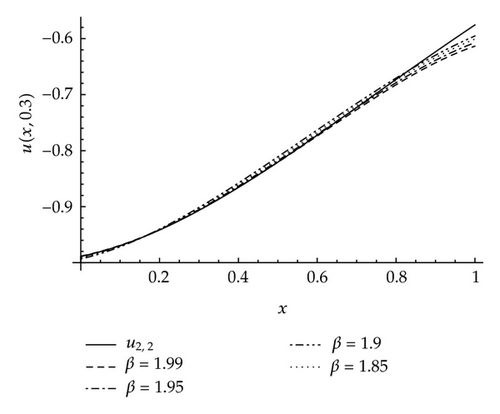
Case 3 (both α and β ∈ (1,2]). Carrying out the same procedure as in Case 2, we get
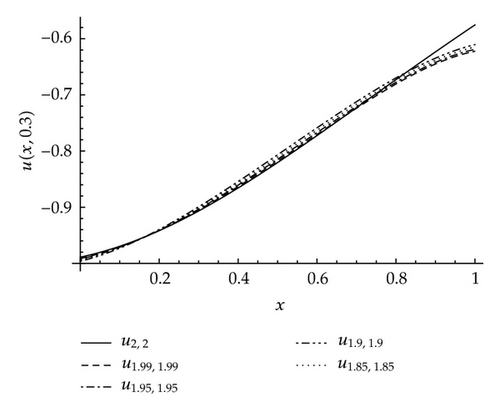
5. Conclusion
The reliable treatment HPM is applied to obtain the solution of the Klien-Gordon partial differential equation of arbitrary (fractional) orders with spatial and temporal fractional derivatives. The main advantage of this algorithm is the capability to overcome the difficulty arising in calculating complicated integrals when dealing with nonlinear problems. The numerical examples carried out show good results, and their graphs illustrate the continuation of the solution of fractional-order Klien-Gordon equation to the solution of the corresponding second-order problem when the fractional-order parameters approach their integer limits.




